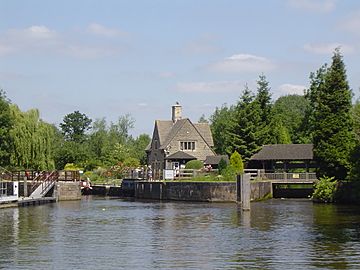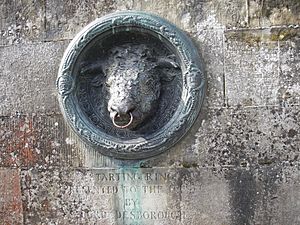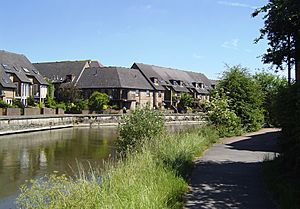Iffley Lock facts for kids

Iffley Lock from downstream
|
|
| Waterway | River Thames |
|---|---|
| County | Oxfordshire |
| Maintained by | Environment Agency |
| Operation | Hydraulic |
| First built | 1631 |
| Latest built | 1927 |
| Length | 46.96 m (154 ft 1 in) |
| Width | 6.47 m (21 ft 3 in) |
| Fall | 0.81 m (2 ft 8 in) |
| Above sea level | 178' |
| Distance to Teddington Lock |
91 miles |
| Coordinates | 51°43′42.45″N 1°14′25.21″W / 51.7284583°N 1.2403361°W |
Iffley Lock is a special kind of gate on the River Thames in England. It is located near the village of Iffley, which is on the southern edge of Oxford. Locks help boats move safely between different water levels on a river.
The first lock here was built in 1631. It was later replaced in 1793. Iffley Lock also has a set of rollers. These rollers allow smaller boats like punts and rowing boats to be moved easily between the higher and lower water levels.
Besides the main lock and its weir, there is another stream to the east. This stream used to be called the Mill Stream. The weir is located just downstream from the lock. This is where the weir stream meets the old mill stream.
Contents
History of Iffley Lock
A weir, which is like a small dam, was present here as early as 1302. It was owned by Lincoln College. This weir might have supported a bridge even before that time.
Building the First Lock
Iffley Lock was the first "pound lock" built furthest upstream by the Oxford-Burcot Commission in 1631. A pound lock is a section of water with gates at both ends. It allows boats to be raised or lowered.
In 1790, the Thames Commissioners took over Iffley Lock. They also took over other locks built by the Oxford-Burcot Commission. These included the locks at Sandford and Swift Ditch.
Changes and Improvements
The Thames Commissioners rebuilt Iffley Lock in 1793. The person in charge of the lock, called the keeper, was told to collect money from boats. This money, called a "toll," was for punts, pleasure boats, skiffs, and wherry boats. Punts and skiffs cost sixpence, while four-oared boats cost one shilling.
It was a bit tricky for large boats, like barges, to get through the lock. They often had to go in backwards and lower their masts. To make things better, the lock was improved and made bigger in 1802 and 1806. A stone building for the lock keeper was also built in 1810.
In the mid-1800s, there were problems with low water levels below the lock. Sometimes, the lock was even blamed for causing floods in Oxford.
A special slide for boats was promised in 1885. Around the same time, the Thames Conservancy thought about removing the lock completely. However, many people asked for it to stay, and so it did. The lock was last rebuilt in 1927.
How to Reach Iffley Lock
You can get to Iffley Lock by walking. There is a path from Donnington Bridge on the western side. You can also walk from Iffley village on the eastern side. You can even walk across the lock itself.
The River Above Iffley Lock
The part of the river around Oxford is sometimes called the Isis. Upstream from Iffley Lock, you will find Donnington Bridge crossing the river. Then, the River Cherwell joins the Thames on the northern side.
University Boathouses and Rowing
Along the northern bank, you will see the boathouses of the university colleges. After these, you will pass Christ Church Meadow. This part of the river is very popular for rowing. It is where the university holds its big rowing races, like Torpids and Summer Eights.
Bridges and Suburbs
After Christ Church Meadow, you will reach Folly Bridge. This is where many pleasure boats dock. Beyond Folly Bridge, the river flows through suburban areas. Here, it is crossed by Grandpont Bridge. Further along, you will see the Gasworks Bridge, which used to be a railway bridge. Finally, there is the Osney Rail Bridge.
The Thames Path is a long-distance walking trail. It stays on the western side of the river towards South Hinksey until it reaches Osney Lock.




